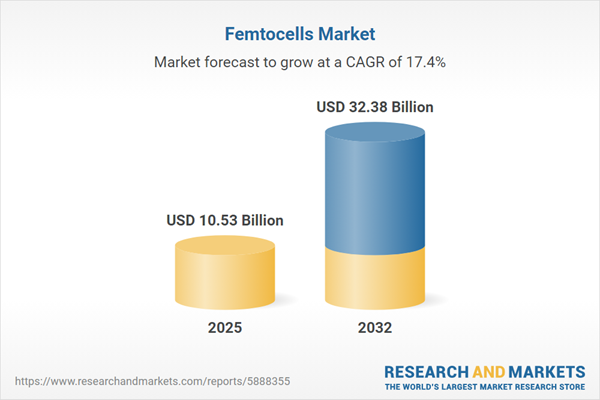Speak directly to the analyst to clarify any post sales queries you may have.
The femtocells market is rapidly reshaping wireless infrastructure strategies, empowering senior decision-makers to unlock greater indoor connectivity reliability and position their organizations for seamless digital transformation across commercial spaces.
Market Snapshot: Femtocells Market Growth and Opportunity
The global femtocells market continues to gain traction, with projections indicating growth in market size from USD 8.95 billion in 2024 to USD 10.53 billion in 2025 and further anticipated expansion to USD 32.38 billion by 2032 at a CAGR of 17.43%. This consistent upward trend is supported by accelerating digitalization across industries, the emergence of dense urban environments, and a mounting demand for high-performance indoor wireless networks. Enterprises and operators are navigating a landscape of increasing device connectivity and complex operational needs, leading to the adoption of advanced femtocell solutions that promise adaptive and resilient coverage for modern commercial scenarios.
Scope & Segmentation of the Femtocells Market
- Product Types: Enterprise femtocells, public femtocells, and residential femtocells, each designed to deliver optimized wireless performance in corporate, shared, and private environments.
- Technology Standards: Compatibility with 3G, 4G LTE, and 5G facilitates smooth transitions across wireless generations, helping future-proof infrastructure investments.
- Connectivity Interfaces: Deployment options include DSL, Ethernet, active fiber, GPON, and wireless backhaul, providing flexibility for integration into different network architectures.
- End Users: Solutions address the coverage demands of enterprises, consumers, and SOHO segments, supporting tailored connectivity strategies.
- Applications: Femtocells enable mission-critical voice and data networks in sectors such as healthcare, education, manufacturing, and real estate, where network continuity is essential.
- Price Tiers: Economy and premium categories accommodate varying procurement strategies and budget considerations for diverse organizations.
- Deployment Modes: Options for indoor and outdoor installations ensure adaptability for complex facility layouts and dense commercial contexts.
- Distribution Channels: Available through direct sales, authorized distributors, digital platforms, and retail networks, enabling customized purchasing approaches.
- Frequency Bands: Support for licensed and unlicensed spectrums offers compliance and rollout flexibility internationally.
- Regions: Activity is prominent across Americas, Europe, the Middle East and Africa, and Asia-Pacific, with adoption strong in countries like the United States, Brazil, Germany, China, India, and Australia.
- Leading Companies: Key providers include Huawei Technologies, LM Ericsson, Nokia Solutions and Networks, Alcatel-Lucent International, Cisco Systems, NEC Corporation, ZTE Corporation, Samsung Electronics, Airvana, and ip.access Limited.
Key Takeaways and Strategic Insights
- Femtocells empower organizations with scalable, resilient wireless infrastructures to meet changing operational demands as business landscapes evolve.
- Their compatibility with a wide array of devices and network providers extends asset longevity and smooths transitions to updated wireless standards, reducing upgrade hurdles.
- Consistent, high-quality wireless coverage is essential for spaces where operational consistency and secure connectivity are business-critical, including corporate offices and healthcare settings.
- Integrating femtocells with edge computing infrastructure enables efficient deployment of IoT solutions and facilitates real-time analytics, supporting responsive and data-driven decision-making.
- To account for dynamic supply conditions, vendors are adopting diversified supply chain strategies and forming strategic partnerships to ensure reliable, consistent fulfillment.
- Collaboration among leading manufacturers, service providers, and system integrators drives deployment reliability, streamlined project execution, and simplified adoption of next-generation wireless technologies for enterprises.
Tariff Impact on Market Dynamics
Recent U.S. tariffs on telecommunications equipment are prompting manufacturers to redesign supply chains by moving assembly steps closer to end markets. This approach helps mitigate cost impacts and supports service providers in sustaining predictable delivery timelines. Strategic inventory management and robust business partnerships maintain momentum even as the trade landscape fluctuates.
Methodology & Data Sources
This analysis incorporates direct feedback from network operators, technology vendors, and distributors, complemented by targeted industry research and regulatory assessments. The result is actionable, enterprise-ready intelligence for evaluating femtocell deployments.
Femtocells Market: Primary Keyword in Focus
The femtocells market is fundamental to forming forward-looking enterprise wireless strategies, supporting adaptable connectivity, and enabling digital initiatives suited to complex business requirements.
Why This Report Matters
- Guides decision-makers in shaping wireless network plans aligned with organizational goals, ensuring effective procurement and implementation.
- Delivers clear segmentation and provider insights to facilitate global benchmarking and regulatory compliance assessment.
- Enables informed technology and vendor selection, supporting cost efficiency and ensuring continuity in digital transformation initiatives.
Conclusion
This report provides senior executives with the insights needed to advance wireless infrastructure, streamline technology adoption, and leverage femtocell capabilities for long-term business advantage.
Additional Product Information:
- Purchase of this report includes 1 year online access with quarterly updates.
- This report can be updated on request. Please contact our Customer Experience team using the Ask a Question widget on our website.
Table of Contents
3. Executive Summary
4. Market Overview
7. Cumulative Impact of Artificial Intelligence 2025
Companies Mentioned
The companies profiled in this Femtocells market report include:- Huawei Technologies Co., Ltd.
- Telefonaktiebolaget LM Ericsson
- Nokia Solutions and Networks Oy
- Alcatel-Lucent International S.A.
- Cisco Systems, Inc.
- NEC Corporation
- ZTE Corporation
- Samsung Electronics Co., Ltd.
- Airvana, Inc.
- ip.access Limited
Table Information
| Report Attribute | Details |
|---|---|
| No. of Pages | 198 |
| Published | October 2025 |
| Forecast Period | 2025 - 2032 |
| Estimated Market Value ( USD | $ 10.53 Billion |
| Forecasted Market Value ( USD | $ 32.38 Billion |
| Compound Annual Growth Rate | 17.4% |
| Regions Covered | Global |
| No. of Companies Mentioned | 11 |









